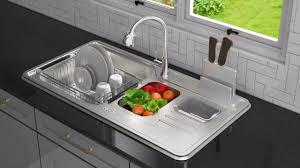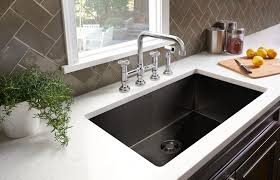Everything You Need to Know About Undermount Sinks
Choosing a sink is an important part of any renovation for kitchen, bathroom or even wet bar. There are different styles, materials, and designs of sinks to choose from. The first thing to think about is the installation type, including the most popular installation methods: drop-in and undermount. For kitchen and bathroom renovations, there are some great benefits to undermount sinks.
Thinking about putting in an undermount sink? Here’s everything you need to know:
What is an Undermount Sink?
While drop-in sinks have visible rims on top of the counter, an undermount sink is installed from below. The rim attaches to the bottom of the counter, so it isn’t visible.
So how do undermount sinks stay in place? Undermount kitchen sinks or undermount bathroom sinks are held in place by high-strength epoxies, anchors and clips, and silicone caulk, according to Ask the Builder.

Sink Style: Undermount
- Distinctive Features: The edge lip of the sink is mounted below a solid surface countertop, so the sink effectively hangs underneath the counter, as opposed to sitting on top of it; creates a continuous flow from countertop into sink.
- Countertop Compatibility: Best suited for solid surface countertop materials like granite, soapstone, marble, or concrete. NOT well suited for laminate or tile counters, which have too many weak points along seams and grout lines to support the weight of the sink.
- Pros: Wipe food scraps straight into the sink (no exposed rim to catch crumbs and dirt); reclaim up to half a square foot of counter space; attractive, minimalist look, easy to clean.
- Cons: Generally more expensive than drop-in sinks; only works with weight-bearing and water-resistant countertop materials; condensation build-up under the counter can cause mold; faucets must be attached to the countertop or wall.
- Installation: Proper installation and sealing is crucial to prevent leakage and to make sure the sink is properly supported. (A full sink of dishes gets very heavy. You don’t want the sink pulling apart from the underside of your countertop and crashing to the floor.) Undermount sinks are typically attached with a two-part epoxy adhesive and sealed with silicone caulking around the perimeter. Make sure to get a professional or someone who knows what they’re doing. Most professionals can install an undermount kitchen sink in 30 minutes or less.

Undermount Kitchen Sink Advantages
- Reduced Cleaning Demands
A countertop does not demand as much cleaning as the sink edge resting on it. With an undermount kitchen sink, this edge is tucked out of sight below the countertop, and it does not need cleaning as no debris falls on it. Therefore, cleaning up and undermount sink is much easier. The task of cleaning out the dirt that often gets trapped between the sink rim and the countertop is also eliminated since the rim is no longer part of the sink’s design. In fact, a thorough clean up is usually very simple, involving a wet or a dry cloth.
- Various Sizes Available
The choice of undermount kitchen sink sizes is just as vast as that of regular sinks. Therefore, you will not have to make any compromise in this regard when you decide to pick an undermount kitchen sink over a regular sink. Various shapes are also available depending on your design preferences. For this reason, the best undermount kitchen sinks should stand up and even surpass the utility that traditional sinks have to offer. In length, these sinks measure about 22 to 33 inches, and in width, they measure about 12 to 33 inches. Their depth can vary from 5 to 9 inches.
- They Look Better
Undermount kitchen sinks have a neat seamless flowing aesthetic appeal since the sink ring, whose role is more functional than aesthetic, is not visible after the sink is installed. Many times, the sink rim can be quite an eyesore, especially when it does not go well with the countertop’s design. Generally, countertops offer a lot of beauty in comparison to sinks. Therefore reducing a sink’s visual impact on a kitchen’s design is great at helping enhance its appeal. For even better results, this kind of kitchen sink can be installed under the cabinet so that you do not have to deal with the sight of the drainage pipes and other kinds of plumbing that might make your kitchen less visually appealing. These sinks also tend to go well with many countertop options, including concrete and granite.

Disadvantage
Despite their practicality and style, there are some disadvantages to undermount sinks to keep in mind. Undermount sinks are harder to install than drop-in sinks and are often more expensive. They work best when combined with a waterproof countertop, because the edge of the countertop will be exposed to water. Undermount sinks are a great choice for solid surface and granite countertops, for example, but aren’t generally recommended for laminate. Undermount sinks are sometimes installed with laminate countertops even though water damage is a potential concern; if you consider this option, make sure you find an experienced fabricator/installer. Since the bottom of an undermount sink will be an inch or so lower than a drop-in model, it may require more bending over to work in the sink. Also keep in mind that because a custom hole is cut into the countertop for an undermount sink, it may be more difficult to replace the sink later — so it’s especially important to buy a good quality sink.
Things to Consider with Undermount Sinks
While there are many benefits to undermount sinks, there are some things to consider before choosing one for your kitchen or bathroom renovation.
If you prefer DIY installation, this may not be the style for you. Undermount sinks are not as easy to install as drop-in kitchen and bathroom sinks. If there’s already a cut-out in place in the counter fitting the sink dimensions, a drop-in sink is usually simple and painless for homeowners to install on their own. This is not usually the case for undermount sinks.
Undermount sinks are typically more expensive than drop-in sinks. Costs are higher for both the materials and the labour involved in an installation.
Lastly, consider your countertop material. You can attach an undermount sink to all countertop materials except for laminate. Unlike undermount sinks, drop-in sinks can be installed on any and all countertop types and materials.